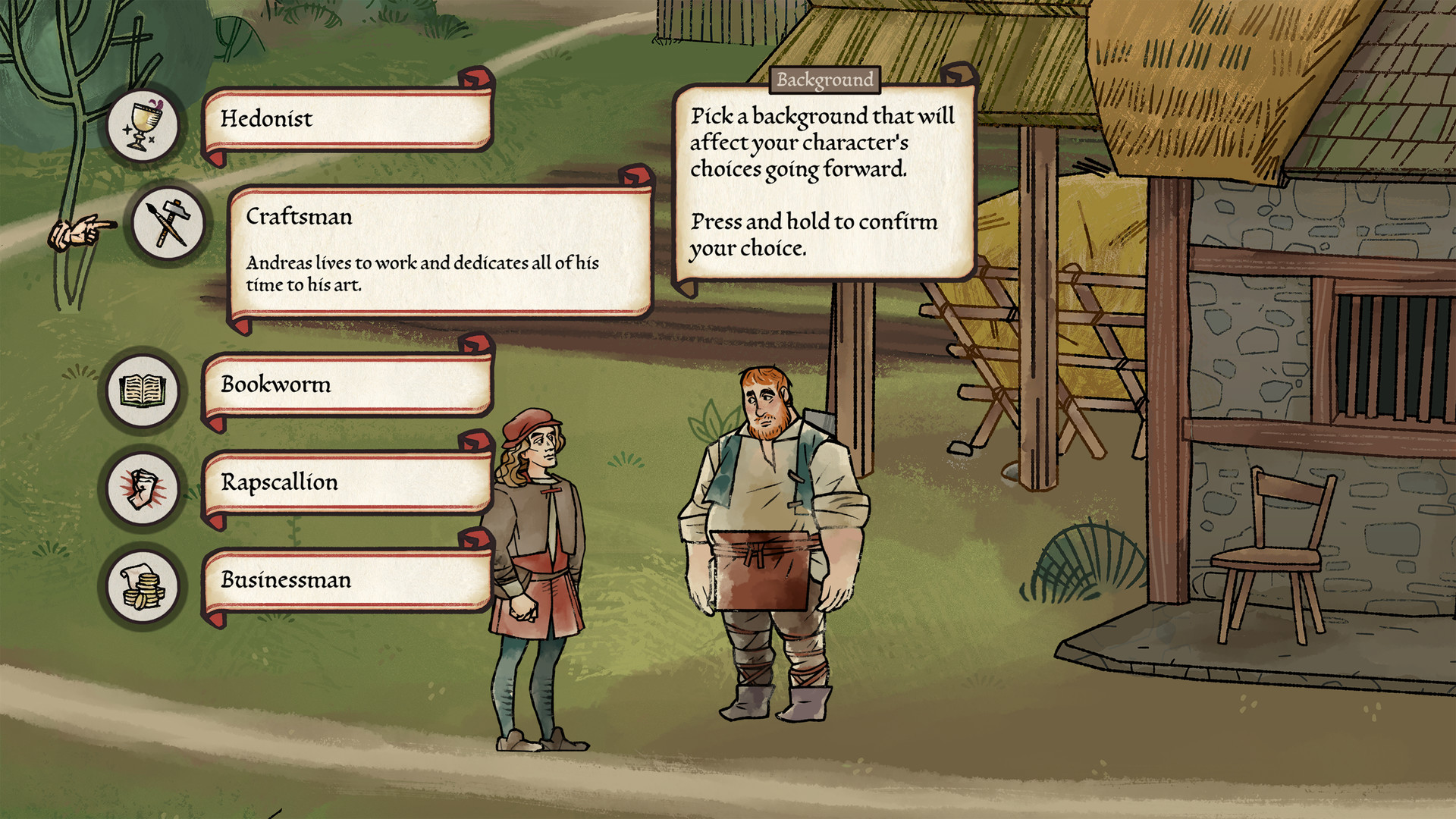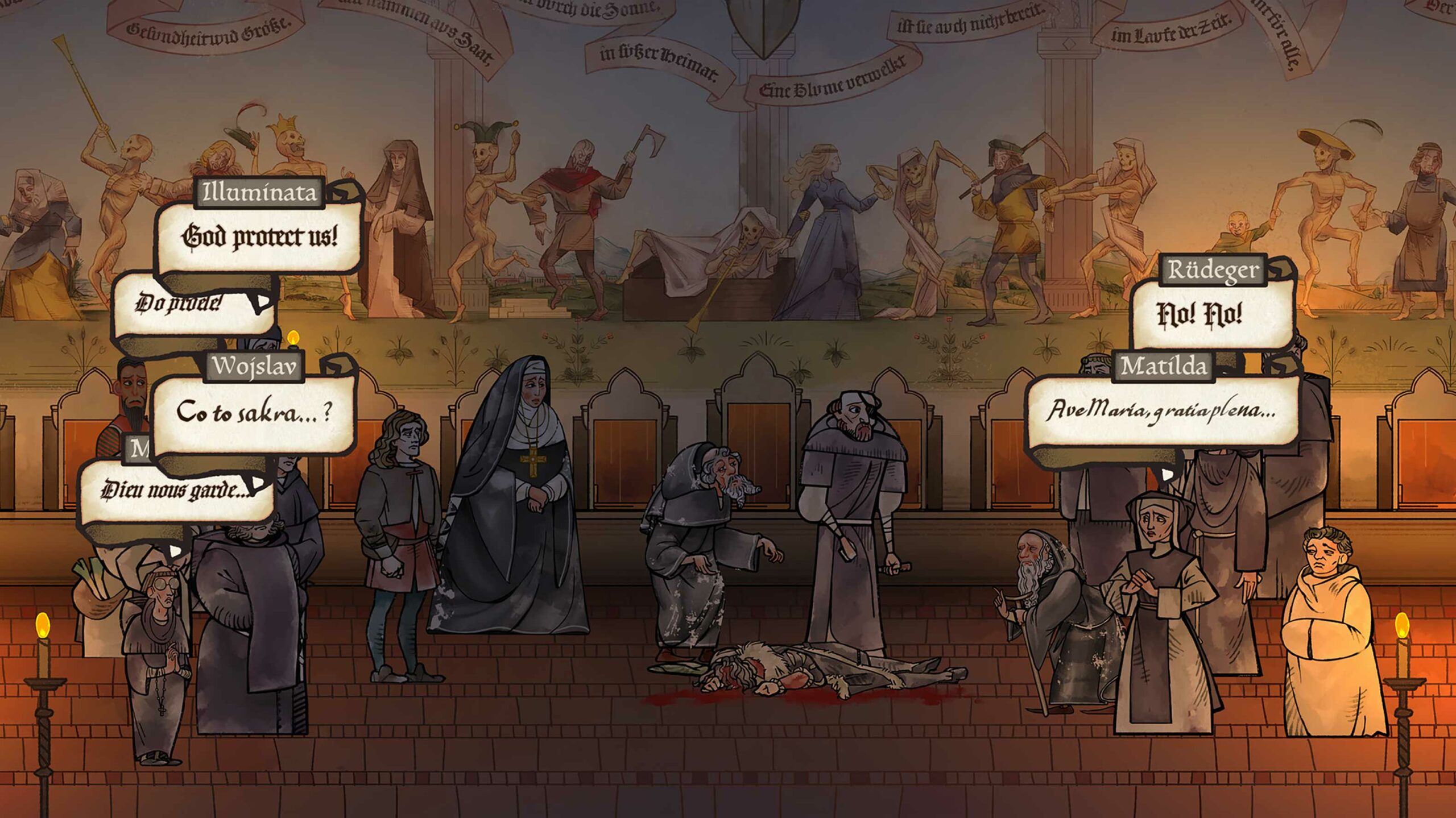
In a way, Obsidian Entertainment’s Pentiment has been 30 years in the making.
Josh Sawyer, the prolific game developer behind such hits as Fallout: New Vegas and Pillars of Eternity, had early ideas for Pentiment dating back to 1992. Over time, that original pitch has evolved into what we now see today: a historical narrative adventure in which journeyman artist Andreas Maler must investigate a prominent murder. While Xbox-owned Obsidian continues to toil away at big RPGs like Avowed and The Outer Worlds 2, Sawyer has led a small team within the studio to craft Pentiment.
To learn more about the game, MobileSyrup sat down with Alec Frey, senior producer on Pentiment, who discussed the game’s unique historical setting, approach to player choice, accessibility and more.
Question: Obsidian is known for these big, dense RPGs. What was the appeal of doing a smaller, tighter experience in Pentiment?
Frey: Yeah, that’s a great question. I think one of the coolest things about Obsidian and working under Microsoft is they’re letting us kind of experiment with a lot of different things that we have ideas for. And Pentiment, while it’s a different game, has a lot of the same heart and soul of Obsidian games. It’s got a deep world. It’s got choice and consequence — like really powerful decision making. It’s got a strong story — it tells an important story, we think. And that’s a lot of the same things that come with all Obsidian games. So it has a lot of that same heart. And I think the biggest thing that kind of drove us to do it was our game director, Josh, had a great idea. A lot of us thought it sounded really cool and wanted to work on it, and we kind of got together and and just started making it, and it turned into this really cool thing that everyone’s really kind of attached to.
Q: What is it about the 16th-century Bavaria setting that you think is so interesting?
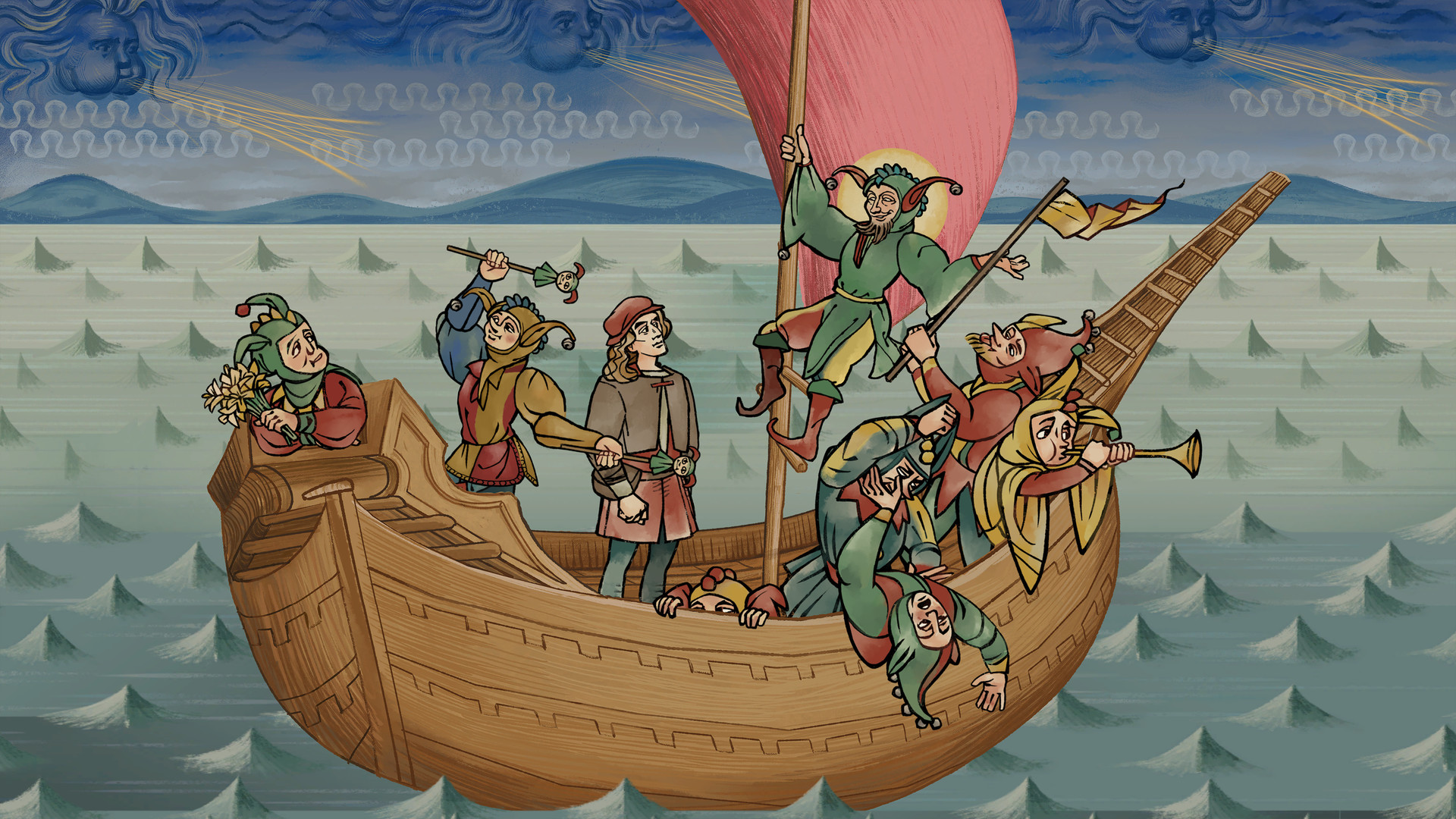 Frey: First of all, Josh wanted to go there, because it’s something that he he has a lot of history in studying and he knows a lot about. And he thought it was a kind of an interesting setting for a lot of different reasons. First of all, the printing press had just been invented and was starting to gain popularity. And what that did was it caused more people to have access to books and texts and reading, and a lot more people were learning how to read. At the same time, there was a lot of change happening in the church. So [German priest] Martin Luther was starting to fan the flames of the Reformation and having people kind of ask questions about what religion meant and what the church should be doing with what power they have. And that information was able to be spread due to the advent of the printing press. So that combination of things caused a lot of social and political upheaval and change, and telling a story in that environment sounded really cool and really appealing to us. So that’s a big part of why the setting is where it is and when it is.
Frey: First of all, Josh wanted to go there, because it’s something that he he has a lot of history in studying and he knows a lot about. And he thought it was a kind of an interesting setting for a lot of different reasons. First of all, the printing press had just been invented and was starting to gain popularity. And what that did was it caused more people to have access to books and texts and reading, and a lot more people were learning how to read. At the same time, there was a lot of change happening in the church. So [German priest] Martin Luther was starting to fan the flames of the Reformation and having people kind of ask questions about what religion meant and what the church should be doing with what power they have. And that information was able to be spread due to the advent of the printing press. So that combination of things caused a lot of social and political upheaval and change, and telling a story in that environment sounded really cool and really appealing to us. So that’s a big part of why the setting is where it is and when it is.
Q: What sorts of research goes into that setting? Especially when you’re a smaller team among the larger Obsidian fold, what does that look like when you’re researching into this distant setting?
Frey: So there’s a lot of different things. First of all, Josh got access to as many books and old things as possible. When you play the game, you can take a look at the credits. And at the end, you’ll notice there’s a bibliography that lists all the stuff that we referenced in text. So that’s a really big first step — we looked at a lot of old stuff. We also reached out to a handful of consultants. So we have three major consultants and a lot of other people that helped out that were experts in illuminated manuscripts, experts in the time period. They’re historians, professors, things like that. And we would reach out to them when we had questions on that sort of thing. So that was a big part of it.
 Within the team, we wanted to all really delve deep into the setting and understand it really well. So we very commonly would spend, for a pretty long amount of time regularly on Thursday evenings, the team would get together. We were all remote, so we’d get together on a call. And we would watch something or play something together that we thought would help us understand the setting more — quite often that was a show or a documentary. And we would dig really deep into that sort of stuff. So we got inspiration from all sorts of sources. And we made sure to look into things like documentaries that could educate the whole team. And it was really cool. It had this really cool effect where over the course of the project, you saw all of the team — which, yeah, the core group is like 14 people, it’s not very big — kind of learn this part of history and become semi-experts at it and all get a lot more knowledge on this time period. And that was really cool to kind of be able to correct ourselves and the old stuff we worked on as we went to and be like, ‘Oh, this isn’t accurate, wow.’ And we got to talk about that a lot, so that was really cool.
Within the team, we wanted to all really delve deep into the setting and understand it really well. So we very commonly would spend, for a pretty long amount of time regularly on Thursday evenings, the team would get together. We were all remote, so we’d get together on a call. And we would watch something or play something together that we thought would help us understand the setting more — quite often that was a show or a documentary. And we would dig really deep into that sort of stuff. So we got inspiration from all sorts of sources. And we made sure to look into things like documentaries that could educate the whole team. And it was really cool. It had this really cool effect where over the course of the project, you saw all of the team — which, yeah, the core group is like 14 people, it’s not very big — kind of learn this part of history and become semi-experts at it and all get a lot more knowledge on this time period. And that was really cool to kind of be able to correct ourselves and the old stuff we worked on as we went to and be like, ‘Oh, this isn’t accurate, wow.’ And we got to talk about that a lot, so that was really cool.
Q: You can speak to this from the producer side of things. What’s it like to be a very small team among the larger studio? How does the workload get divided with everyone pitching in towards the overall project?
Frey: The bigger teams at Obsidian, in general, have a lot more lines of communication from a production standpoint, right? Like, you have 5-8 people in each department, and suddenly, those departments need to communicate with other departments that have 5-8 people in them. And you get this massive web of communication where miscommunication can happen — it requires a better structure of organization. On a smaller team, we found that those lines of communication are much smaller; a lot of our departments only have one person in them, maybe two, and communication is just so much stronger. The vision is clear. And you can see that in the game, too. It’s very clear — everybody knows what they’re working on. And when you play this game, we take pride in the fact that this game really knows what it is. And so it’s that small structure of people communicating that is the biggest aspect of being a small team.
But there’s other parts to it, too, where because it’s a small team you can self-organize quicker, you can iterate a little bit quicker. If you need to change things, it’s easier to tell people what that change is and get them on board faster. Culture changes and culture growth is quicker and more agile and stuff like that. So from a production perspective, I think you get a team that can pivot quickly, change ideas quickly, iterate quickly. And all of that is just such a cool advantage that you have with a small team. That said, because the departments are only one or two people, oftentimes you have to make decisions — like tough decisions — on what things you want to work on and what’s highest priority. And it becomes a challenge to make sure that you’re understanding who’s blocking each other on work they can do. So from a production perspective, there’s just a big difference. But it’s cool, because you become a tighter knit group of people. And you really become like a group of friends working on a thing together that wants to make the best thing they can and that feels really good.
Q: The art style, led by Hannah Kennedy, is so striking. How many iterations did you go through before you sort of landed on that particular aesthetic, and how do you think it sort of enhances the historical mystery experience?
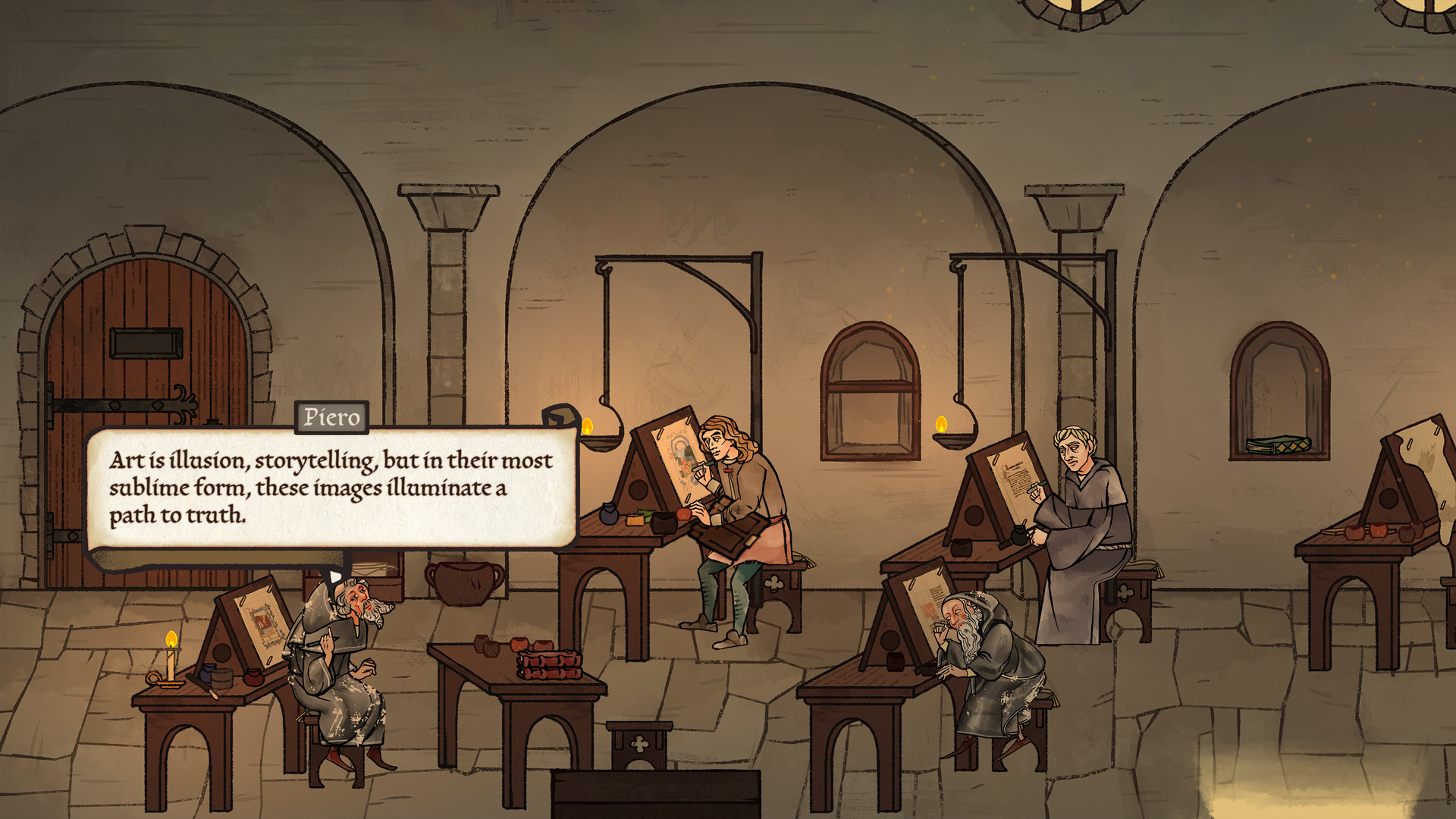 Frey: For iterations, Josh wanted to do like a 2D game, inspired by things like Night in the Woods and Oxenfree and other other adventure games that are kind of in that same field. And we thought, ‘okay, we’re doing 16th-century Bavaria — at the time, the scriptorium and illuminated manuscripts were kind of nearing the end of their life, and the woodblock printing was becoming a bigger thing.'” And so very early on, it was a decision that was made that we were going to kind of try and mesh those two. And that actually comes out in the game — you’ll notice the older characters in the game are more of an illuminated painterly style, and the younger kids look like they’re woodblock printed. And so it actually creates this really cool, like, ‘older characters have a different vibe.’ And as characters age throughout the game, you notice that. So I think that that’s a really cool aspect to how we landed on the style — the iteration on that. Even the very early stuff looks very similar to what the final version is. Some characters got cleaned up and changed; as we went, we discovered some techniques and stuff that we really liked, and we went back and changed and cleaned up some of the older characters. But even the really early stuff has that really illuminated manuscript vibe.
Frey: For iterations, Josh wanted to do like a 2D game, inspired by things like Night in the Woods and Oxenfree and other other adventure games that are kind of in that same field. And we thought, ‘okay, we’re doing 16th-century Bavaria — at the time, the scriptorium and illuminated manuscripts were kind of nearing the end of their life, and the woodblock printing was becoming a bigger thing.'” And so very early on, it was a decision that was made that we were going to kind of try and mesh those two. And that actually comes out in the game — you’ll notice the older characters in the game are more of an illuminated painterly style, and the younger kids look like they’re woodblock printed. And so it actually creates this really cool, like, ‘older characters have a different vibe.’ And as characters age throughout the game, you notice that. So I think that that’s a really cool aspect to how we landed on the style — the iteration on that. Even the very early stuff looks very similar to what the final version is. Some characters got cleaned up and changed; as we went, we discovered some techniques and stuff that we really liked, and we went back and changed and cleaned up some of the older characters. But even the really early stuff has that really illuminated manuscript vibe.
Q: A lot of narratives tend to unfold over a short period of time, like a few days or a week, especially if you have a detective or whoever investigating group of people. It’s usually a small-scale story. What was sort of the idea behind setting Pentiment over the course of 25 years?
Frey: I think what’s really cool, as we’ve talked about, is that choice and consequence at Obsidian is a really important part of our game development. And something that’s really cool about putting the game in a setting where we spend over 25 years allows you to do different things with that choice and consequence. While often just as impactful as other decisions in our other games, these decisions tend to last and you see the waves of them over 25 years. Some of the characters in this game start out as babies and in the end of the game, they have babies themselves, and so you see that growth. And those characters may have been affected by a decision that you did really early on, and you see that wave throughout the entire game. And I think that that’s a big part of that. Also, because our game takes place during this time of change — during this time of the printing press and of Reformation getting started and all that stuff — the 25-year span actually shows you the growth of history. And we can tell you a point in history where that change happens, whereas if we only picked a single week or a single day within that time period, sure, you would get a snippet of people talking about those things happening, but you wouldn’t feel them the same way that you do over that 25-year span.
Q: What takeaways did you have from previous Obsidian games, like Fallout: New Vegas, that you brought to Pentiment?
Frey: All Obsidian games have their own appeal, and the biggest thing is we want to make sure that your choices matter. We want to make sure that when you make a decision that you feel that in the game. Our previous games all have that in their own way. The biggest Obsidian appeal, in my opinion, is actually just that our worlds are really interactive — like you feel like you’re in them and you feel like the decisions you’re making are affecting them. And we have deep lore, deep characters, deep writing, all of that stuff. So across all of our games, I think that we really try to hammer home that lesson of making things feel like you matter.
I think the lessons that we’ve learned from previous games that we brought in are really sticking the landing on things like setting your backgrounds and building the character as you. Things that we’ve done in previous Obsidian games is often, you get to build a unique character from scratch. You build what they look like, you build all that stuff. In this game, you play Andreas Maler, but we still want to make sure that you get to make your Andreas yours. And so I think the one of the biggest lessons that we’ve learned that we brought over is making sure that you feel like this is your character, and that comes through in Pentiment with choosing your backgrounds, and the decisions you make. You can be a real rapscallion Andreas that beats people up and picks fights maybe, or you can go all the way maybe being a more intuitive or intellectual Andreas and try to use your intelligence and wits. I would say that that’s probably the biggest thing that we bring from previous Obsidian titles into Pentiment.
Q: While you might look at Pentiment and think it’s a hardcore sort of detective or puzzle game, Obsidian has emphasized that it’s not that — you didn’t want to get into the weeds complex sort of puzzle mechanics and things like that. What was sort of the rationale behind lessening those sorts of elements and focusing more on the story — where it isn’t necessarily a mechanically deep game and it’s a little more approachable?
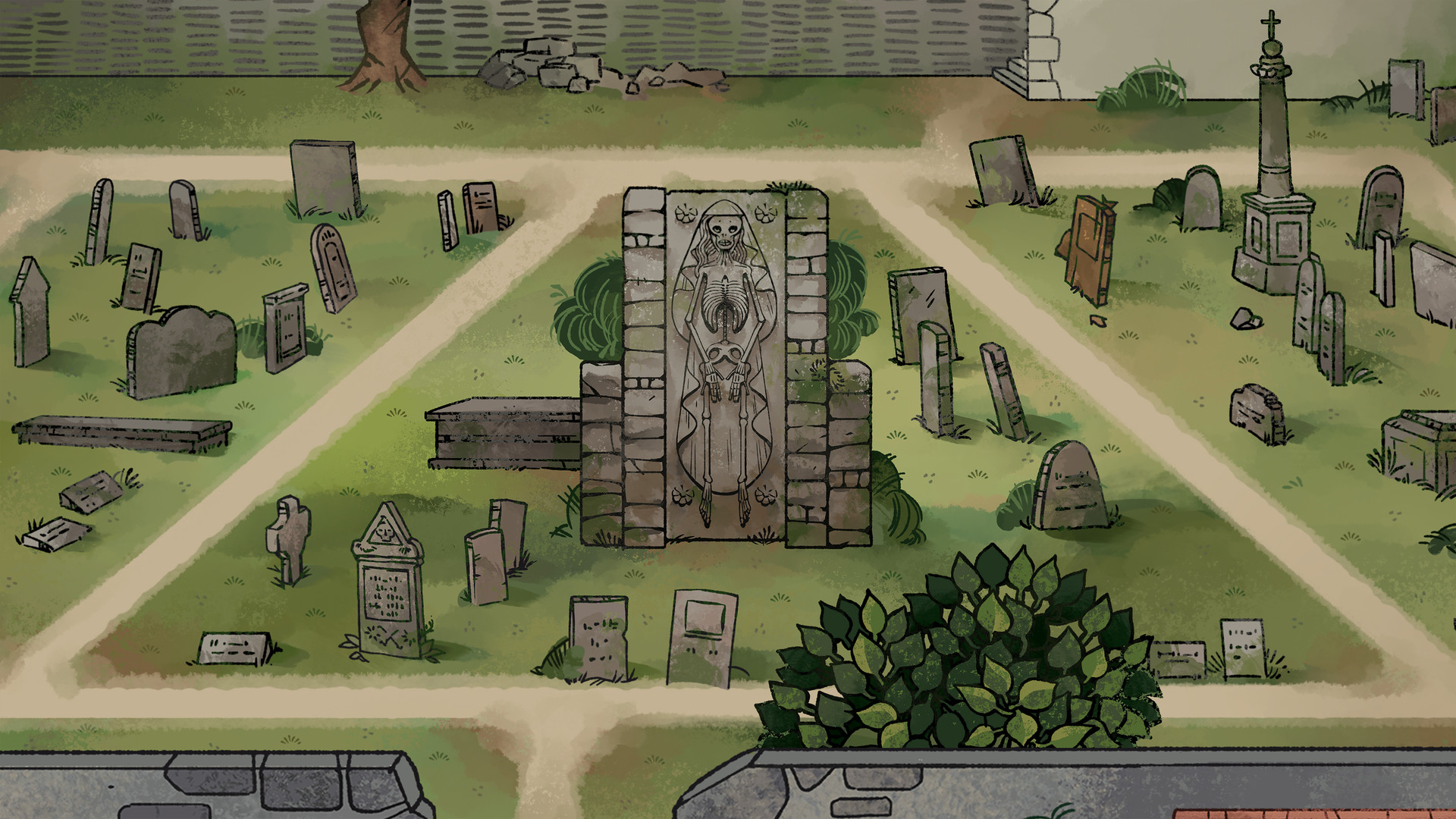 Frey: I think the biggest thing is this is a story that we tell, and first and foremost, because of that, we want to make it narrative first. Also, we’re very good at narrative and we want to bring that forward. We want to take that Obsidian way, the things we thrive at, and we really want to bring them into the story. That said, there are elements to the game that pull you out of that narrative a little bit and let you do other things. We have mini-games, we have exploration, we have other stuff in the game that we want you to interact with. But that first and foremost narrative element is really important to us, and we want to make sure that you understand that you’re reading people talking in a time of the illuminated manuscript. They talk in these special fonts. We have really cool effects when talking to them. The different characters speak differently and faster and slower and make mistakes in their writing. And we wanted to really put our energy into the manuscript in the game, and that’s kind of where it all kind of comes together and makes this narrative-focused adventure. But we also have mini-games and all that stuff, and we placed those in to make sure that they break up reading, but also, some of the things that we want to show to you is there because we want to have you experience it and not just read it. And so sometimes just giving you a mini-game gives you a better understanding of what you’re doing and what you’re playing.
Frey: I think the biggest thing is this is a story that we tell, and first and foremost, because of that, we want to make it narrative first. Also, we’re very good at narrative and we want to bring that forward. We want to take that Obsidian way, the things we thrive at, and we really want to bring them into the story. That said, there are elements to the game that pull you out of that narrative a little bit and let you do other things. We have mini-games, we have exploration, we have other stuff in the game that we want you to interact with. But that first and foremost narrative element is really important to us, and we want to make sure that you understand that you’re reading people talking in a time of the illuminated manuscript. They talk in these special fonts. We have really cool effects when talking to them. The different characters speak differently and faster and slower and make mistakes in their writing. And we wanted to really put our energy into the manuscript in the game, and that’s kind of where it all kind of comes together and makes this narrative-focused adventure. But we also have mini-games and all that stuff, and we placed those in to make sure that they break up reading, but also, some of the things that we want to show to you is there because we want to have you experience it and not just read it. And so sometimes just giving you a mini-game gives you a better understanding of what you’re doing and what you’re playing.
Q: One thing we’ve heard from many companies who have joined Xbox is being able to bring in accessibility options, especially since Microsoft has a big focus on that. What was the process like to bring accessibility to the game and what did it mean for the team to offer those options?
Frey: It was really important to our team from the start to make sure that this game was accessible. For a lot of reasons, we think that this is a game that can reach people outside of just ‘the gamer.’ We think that there’s a lot of people that can enjoy this who maybe are into books or into history or into whatever, but doesn’t necessarily play games. So it was very important to us that anybody could access this game. So early on, decisions were things that we easily identified, like these special fonts that may be hard to read — we want to make sure that we can do anything we can to make that more accessible. So we created a mode that you can turn on; it asks you right at the beginning of the game if you’d like to play an ‘easy read’ font mode, and it swaps it over to more accessible fonts that are much easier to read. And then we also included a text-to-speech option that will read all the text to you — we wanted to make sure that was available to people as well. So those were some really easy early on things that we thought, ‘Oh, we can do this, this is not a problem.’
But then to continue on that process. Microsoft helped us out a lot. They reached out to people that were differently abled and they had them play our game. And they gave us a whole bunch of feedback on things that could be better. And that was incredibly valuable to us. So we sat down and we made a list of the most important things that we thought we had time and resources to work on, and we prioritize that stuff. And we were able to get a lot of it done. Having the game reach as many people as possible is really important to us, and so that’s kind of how that process went. We we hope that people can play it — we really want them to.
Q: We seem to be in this day and age where many people don’t necessarily respond well to endings that don’t wrap up everything in a little bow. It’s interesting, then, that in Pentiment, you don’t actually reveal a canonical murderer. What was the rationale behind that? Was there concern that you might put people off, and how did you go about still telling a satisfying mystery without eventually revealing all the answers?
Frey: I think that something that we want to make sure people realize is that this game is more than a mystery. It’s a span of 25 years of a community’s life, and so there’s a lot more to it than just the mystery. There’s the world and the change and the things that people are going through, so it’s important to us that people dig into this world and see the lives of these people and see how they’re affecting them. There’s a lot of satisfaction in a lot of different places in this game. And I think once you get through the whole thing, you shouldn’t have a problem being satisfied.
This interview has been edited for language and clarity.
Pentiment launches on Xbox consoles and PC on November 15th. It will also be included with Xbox Game Pass on day one.
Image credit: Xbox
MobileSyrup may earn a commission from purchases made via our links, which helps fund the journalism we provide free on our website. These links do not influence our editorial content. Support us here.

